Food and Beverage Management: Trends, Ratings, and Regulations
VerifiedAdded on 2021/02/21
|12
|3616
|19
Report
AI Summary
This report provides a comprehensive overview of the food and beverage (F&B) industry. It begins by exploring various types of F&B businesses, including hotels, restaurants, and culture-based food services, providing examples and outlining their advantages and disadvantages. The report then delves into different rating systems used both nationally and internationally, such as numeric scales, pictorial scales, and five-star ratings, emphasizing their importance for customer evaluation and company improvement. It further discusses current and future trends affecting F&B businesses, with a focus on technology, food preparation techniques, and health and hygiene considerations. The report also highlights essential food and beverage management skills, such as problem-solving and decision-making, crucial for operational efficiency and customer satisfaction. Additionally, it explains the legal requirements and regulatory standards that F&B service outlets must comply with, and compares operational and marketing technologies for different business types. Finally, it investigates consumer decision-making factors and analyzes strategies used to attract and build customer loyalty in the F&B sector.
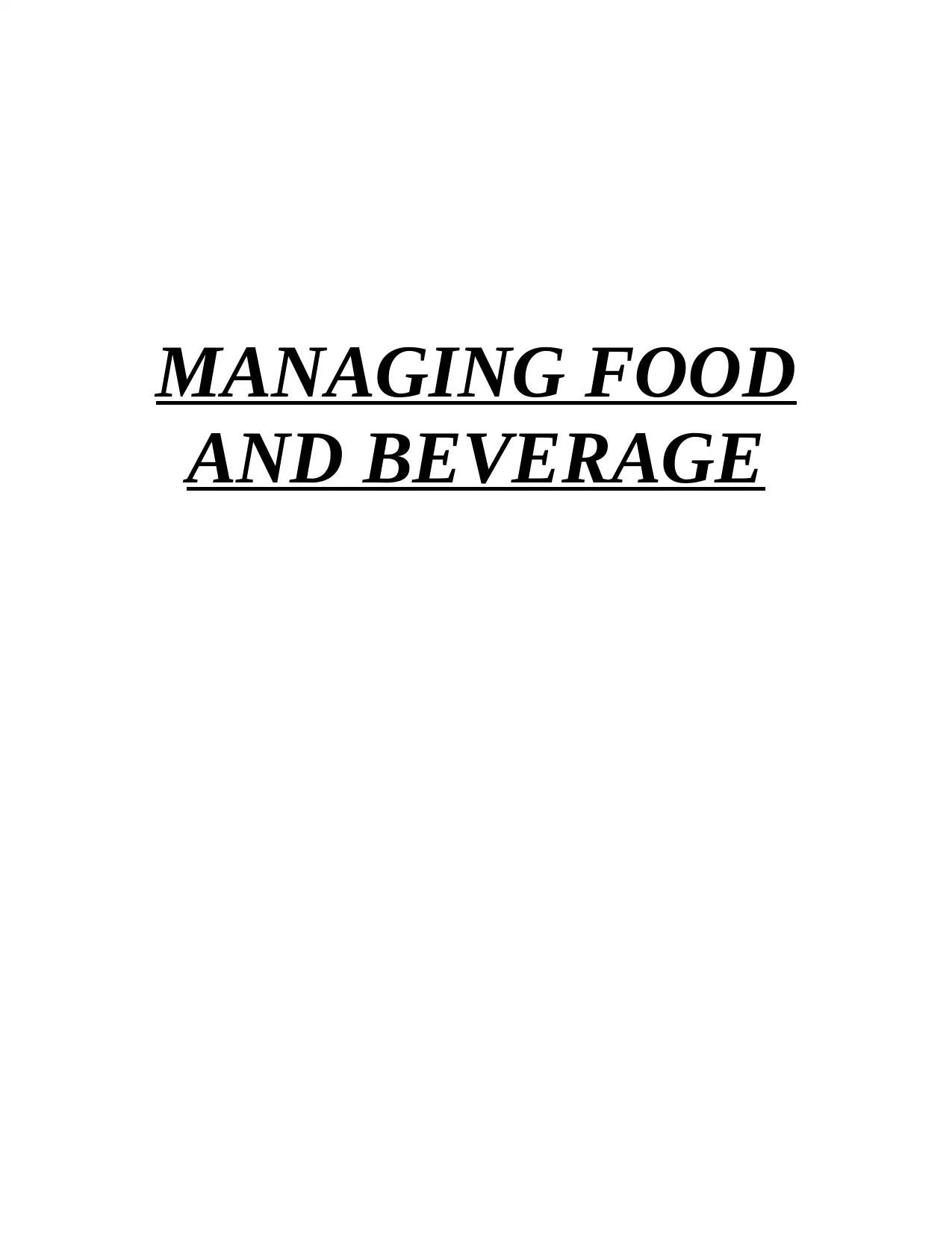
MANAGING FOOD
AND BEVERAGE
AND BEVERAGE
Paraphrase This Document
Need a fresh take? Get an instant paraphrase of this document with our AI Paraphraser
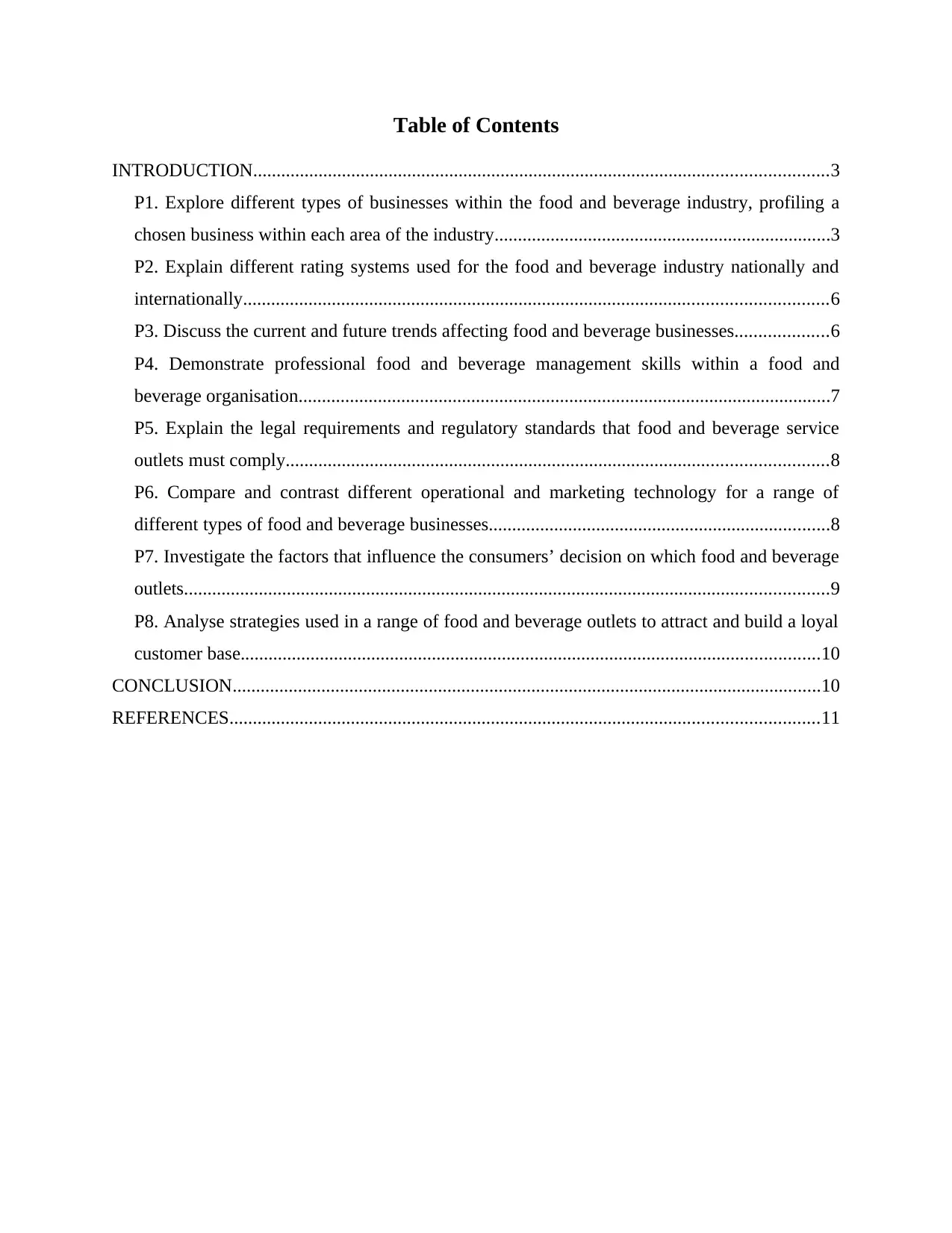
Table of Contents
INTRODUCTION...........................................................................................................................3
P1. Explore different types of businesses within the food and beverage industry, profiling a
chosen business within each area of the industry........................................................................3
P2. Explain different rating systems used for the food and beverage industry nationally and
internationally.............................................................................................................................6
P3. Discuss the current and future trends affecting food and beverage businesses....................6
P4. Demonstrate professional food and beverage management skills within a food and
beverage organisation..................................................................................................................7
P5. Explain the legal requirements and regulatory standards that food and beverage service
outlets must comply....................................................................................................................8
P6. Compare and contrast different operational and marketing technology for a range of
different types of food and beverage businesses.........................................................................8
P7. Investigate the factors that influence the consumers’ decision on which food and beverage
outlets..........................................................................................................................................9
P8. Analyse strategies used in a range of food and beverage outlets to attract and build a loyal
customer base............................................................................................................................10
CONCLUSION..............................................................................................................................10
REFERENCES..............................................................................................................................11
INTRODUCTION...........................................................................................................................3
P1. Explore different types of businesses within the food and beverage industry, profiling a
chosen business within each area of the industry........................................................................3
P2. Explain different rating systems used for the food and beverage industry nationally and
internationally.............................................................................................................................6
P3. Discuss the current and future trends affecting food and beverage businesses....................6
P4. Demonstrate professional food and beverage management skills within a food and
beverage organisation..................................................................................................................7
P5. Explain the legal requirements and regulatory standards that food and beverage service
outlets must comply....................................................................................................................8
P6. Compare and contrast different operational and marketing technology for a range of
different types of food and beverage businesses.........................................................................8
P7. Investigate the factors that influence the consumers’ decision on which food and beverage
outlets..........................................................................................................................................9
P8. Analyse strategies used in a range of food and beverage outlets to attract and build a loyal
customer base............................................................................................................................10
CONCLUSION..............................................................................................................................10
REFERENCES..............................................................................................................................11
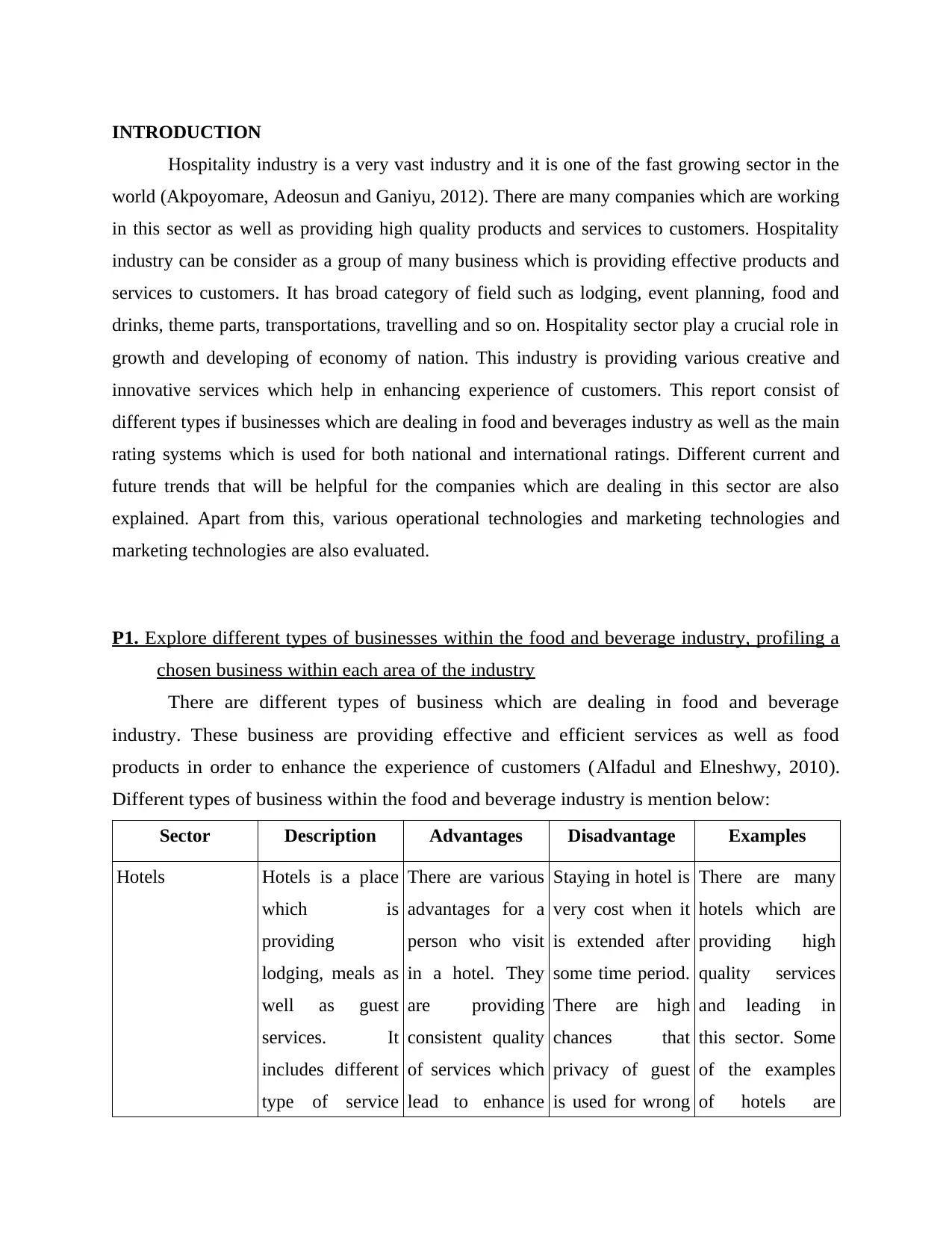
INTRODUCTION
Hospitality industry is a very vast industry and it is one of the fast growing sector in the
world (Akpoyomare, Adeosun and Ganiyu, 2012). There are many companies which are working
in this sector as well as providing high quality products and services to customers. Hospitality
industry can be consider as a group of many business which is providing effective products and
services to customers. It has broad category of field such as lodging, event planning, food and
drinks, theme parts, transportations, travelling and so on. Hospitality sector play a crucial role in
growth and developing of economy of nation. This industry is providing various creative and
innovative services which help in enhancing experience of customers. This report consist of
different types if businesses which are dealing in food and beverages industry as well as the main
rating systems which is used for both national and international ratings. Different current and
future trends that will be helpful for the companies which are dealing in this sector are also
explained. Apart from this, various operational technologies and marketing technologies and
marketing technologies are also evaluated.
P1. Explore different types of businesses within the food and beverage industry, profiling a
chosen business within each area of the industry
There are different types of business which are dealing in food and beverage
industry. These business are providing effective and efficient services as well as food
products in order to enhance the experience of customers (Alfadul and Elneshwy, 2010).
Different types of business within the food and beverage industry is mention below:
Sector Description Advantages Disadvantage Examples
Hotels Hotels is a place
which is
providing
lodging, meals as
well as guest
services. It
includes different
type of service
There are various
advantages for a
person who visit
in a hotel. They
are providing
consistent quality
of services which
lead to enhance
Staying in hotel is
very cost when it
is extended after
some time period.
There are high
chances that
privacy of guest
is used for wrong
There are many
hotels which are
providing high
quality services
and leading in
this sector. Some
of the examples
of hotels are
Hospitality industry is a very vast industry and it is one of the fast growing sector in the
world (Akpoyomare, Adeosun and Ganiyu, 2012). There are many companies which are working
in this sector as well as providing high quality products and services to customers. Hospitality
industry can be consider as a group of many business which is providing effective products and
services to customers. It has broad category of field such as lodging, event planning, food and
drinks, theme parts, transportations, travelling and so on. Hospitality sector play a crucial role in
growth and developing of economy of nation. This industry is providing various creative and
innovative services which help in enhancing experience of customers. This report consist of
different types if businesses which are dealing in food and beverages industry as well as the main
rating systems which is used for both national and international ratings. Different current and
future trends that will be helpful for the companies which are dealing in this sector are also
explained. Apart from this, various operational technologies and marketing technologies and
marketing technologies are also evaluated.
P1. Explore different types of businesses within the food and beverage industry, profiling a
chosen business within each area of the industry
There are different types of business which are dealing in food and beverage
industry. These business are providing effective and efficient services as well as food
products in order to enhance the experience of customers (Alfadul and Elneshwy, 2010).
Different types of business within the food and beverage industry is mention below:
Sector Description Advantages Disadvantage Examples
Hotels Hotels is a place
which is
providing
lodging, meals as
well as guest
services. It
includes different
type of service
There are various
advantages for a
person who visit
in a hotel. They
are providing
consistent quality
of services which
lead to enhance
Staying in hotel is
very cost when it
is extended after
some time period.
There are high
chances that
privacy of guest
is used for wrong
There are many
hotels which are
providing high
quality services
and leading in
this sector. Some
of the examples
of hotels are
⊘ This is a preview!⊘
Do you want full access?
Subscribe today to unlock all pages.

Trusted by 1+ million students worldwide
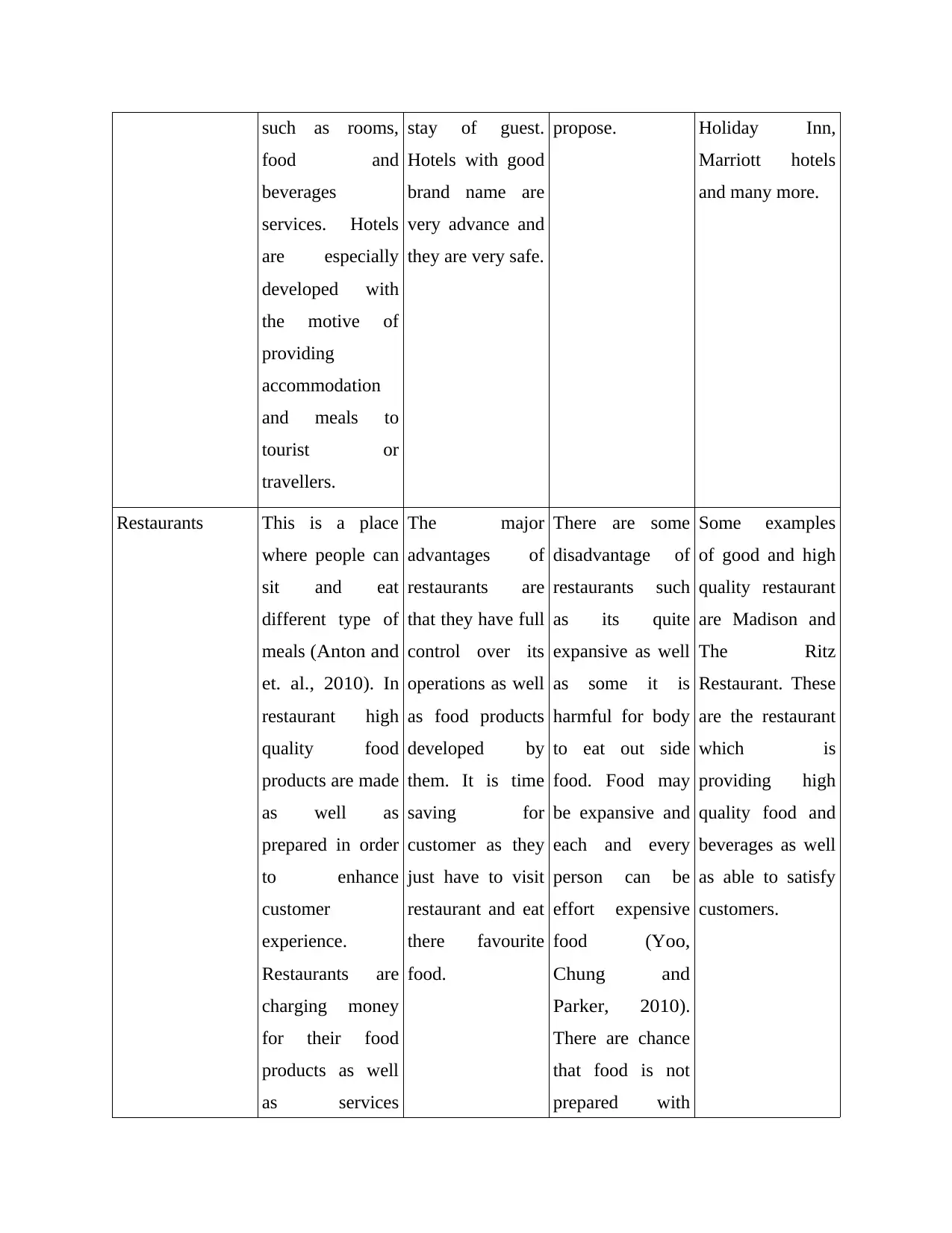
such as rooms,
food and
beverages
services. Hotels
are especially
developed with
the motive of
providing
accommodation
and meals to
tourist or
travellers.
stay of guest.
Hotels with good
brand name are
very advance and
they are very safe.
propose. Holiday Inn,
Marriott hotels
and many more.
Restaurants This is a place
where people can
sit and eat
different type of
meals ( Anton and
et. al., 2010). In
restaurant high
quality food
products are made
as well as
prepared in order
to enhance
customer
experience.
Restaurants are
charging money
for their food
products as well
as services
The major
advantages of
restaurants are
that they have full
control over its
operations as well
as food products
developed by
them. It is time
saving for
customer as they
just have to visit
restaurant and eat
there favourite
food.
There are some
disadvantage of
restaurants such
as its quite
expansive as well
as some it is
harmful for body
to eat out side
food. Food may
be expansive and
each and every
person can be
effort expensive
food ( Yoo,
Chung and
Parker, 2010).
There are chance
that food is not
prepared with
Some examples
of good and high
quality restaurant
are Madison and
The Ritz
Restaurant. These
are the restaurant
which is
providing high
quality food and
beverages as well
as able to satisfy
customers.
food and
beverages
services. Hotels
are especially
developed with
the motive of
providing
accommodation
and meals to
tourist or
travellers.
stay of guest.
Hotels with good
brand name are
very advance and
they are very safe.
propose. Holiday Inn,
Marriott hotels
and many more.
Restaurants This is a place
where people can
sit and eat
different type of
meals ( Anton and
et. al., 2010). In
restaurant high
quality food
products are made
as well as
prepared in order
to enhance
customer
experience.
Restaurants are
charging money
for their food
products as well
as services
The major
advantages of
restaurants are
that they have full
control over its
operations as well
as food products
developed by
them. It is time
saving for
customer as they
just have to visit
restaurant and eat
there favourite
food.
There are some
disadvantage of
restaurants such
as its quite
expansive as well
as some it is
harmful for body
to eat out side
food. Food may
be expansive and
each and every
person can be
effort expensive
food ( Yoo,
Chung and
Parker, 2010).
There are chance
that food is not
prepared with
Some examples
of good and high
quality restaurant
are Madison and
The Ritz
Restaurant. These
are the restaurant
which is
providing high
quality food and
beverages as well
as able to satisfy
customers.
Paraphrase This Document
Need a fresh take? Get an instant paraphrase of this document with our AI Paraphraser
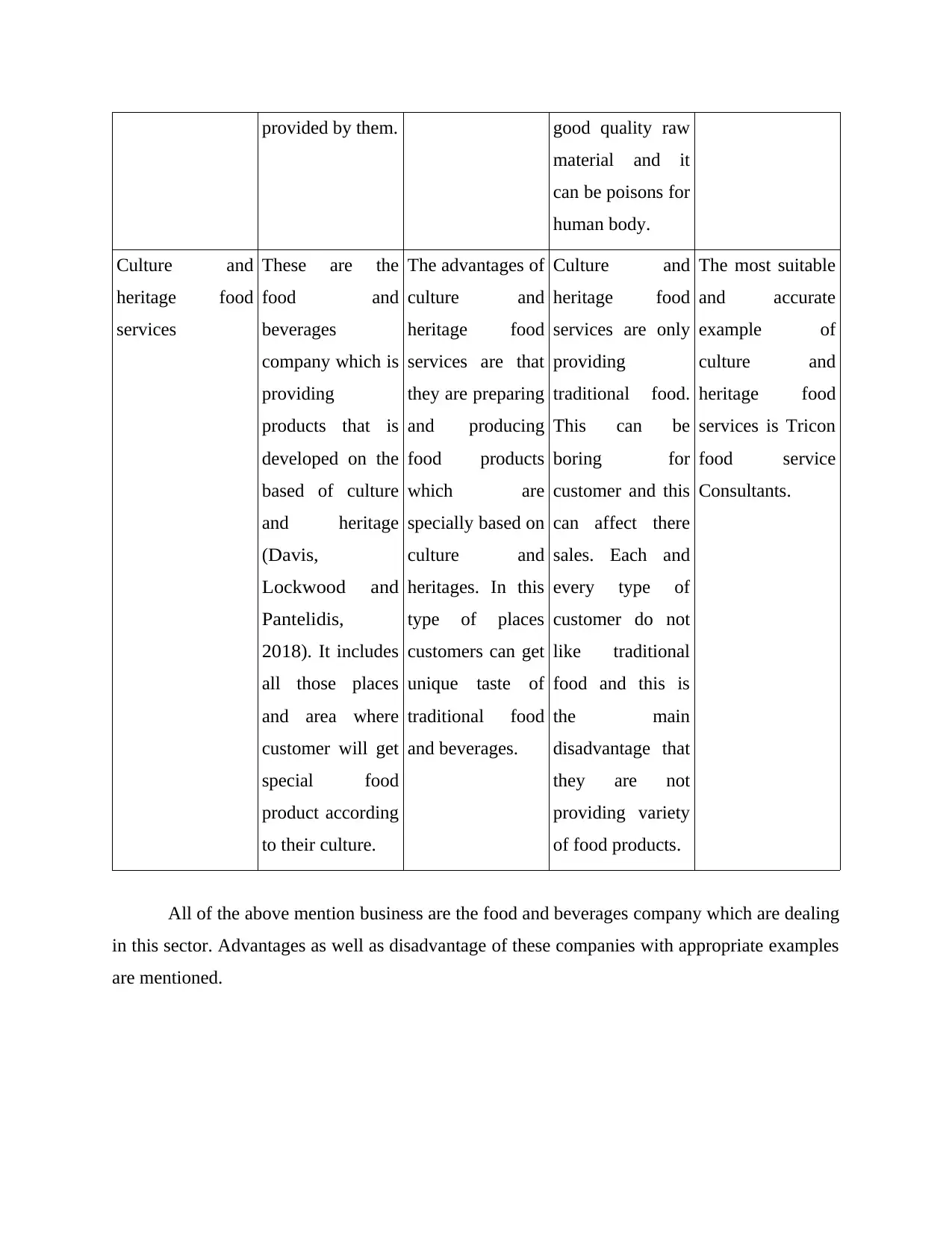
provided by them. good quality raw
material and it
can be poisons for
human body.
Culture and
heritage food
services
These are the
food and
beverages
company which is
providing
products that is
developed on the
based of culture
and heritage
( Davis,
Lockwood and
Pantelidis,
2018). It includes
all those places
and area where
customer will get
special food
product according
to their culture.
The advantages of
culture and
heritage food
services are that
they are preparing
and producing
food products
which are
specially based on
culture and
heritages. In this
type of places
customers can get
unique taste of
traditional food
and beverages.
Culture and
heritage food
services are only
providing
traditional food.
This can be
boring for
customer and this
can affect there
sales. Each and
every type of
customer do not
like traditional
food and this is
the main
disadvantage that
they are not
providing variety
of food products.
The most suitable
and accurate
example of
culture and
heritage food
services is Tricon
food service
Consultants.
All of the above mention business are the food and beverages company which are dealing
in this sector. Advantages as well as disadvantage of these companies with appropriate examples
are mentioned.
material and it
can be poisons for
human body.
Culture and
heritage food
services
These are the
food and
beverages
company which is
providing
products that is
developed on the
based of culture
and heritage
( Davis,
Lockwood and
Pantelidis,
2018). It includes
all those places
and area where
customer will get
special food
product according
to their culture.
The advantages of
culture and
heritage food
services are that
they are preparing
and producing
food products
which are
specially based on
culture and
heritages. In this
type of places
customers can get
unique taste of
traditional food
and beverages.
Culture and
heritage food
services are only
providing
traditional food.
This can be
boring for
customer and this
can affect there
sales. Each and
every type of
customer do not
like traditional
food and this is
the main
disadvantage that
they are not
providing variety
of food products.
The most suitable
and accurate
example of
culture and
heritage food
services is Tricon
food service
Consultants.
All of the above mention business are the food and beverages company which are dealing
in this sector. Advantages as well as disadvantage of these companies with appropriate examples
are mentioned.
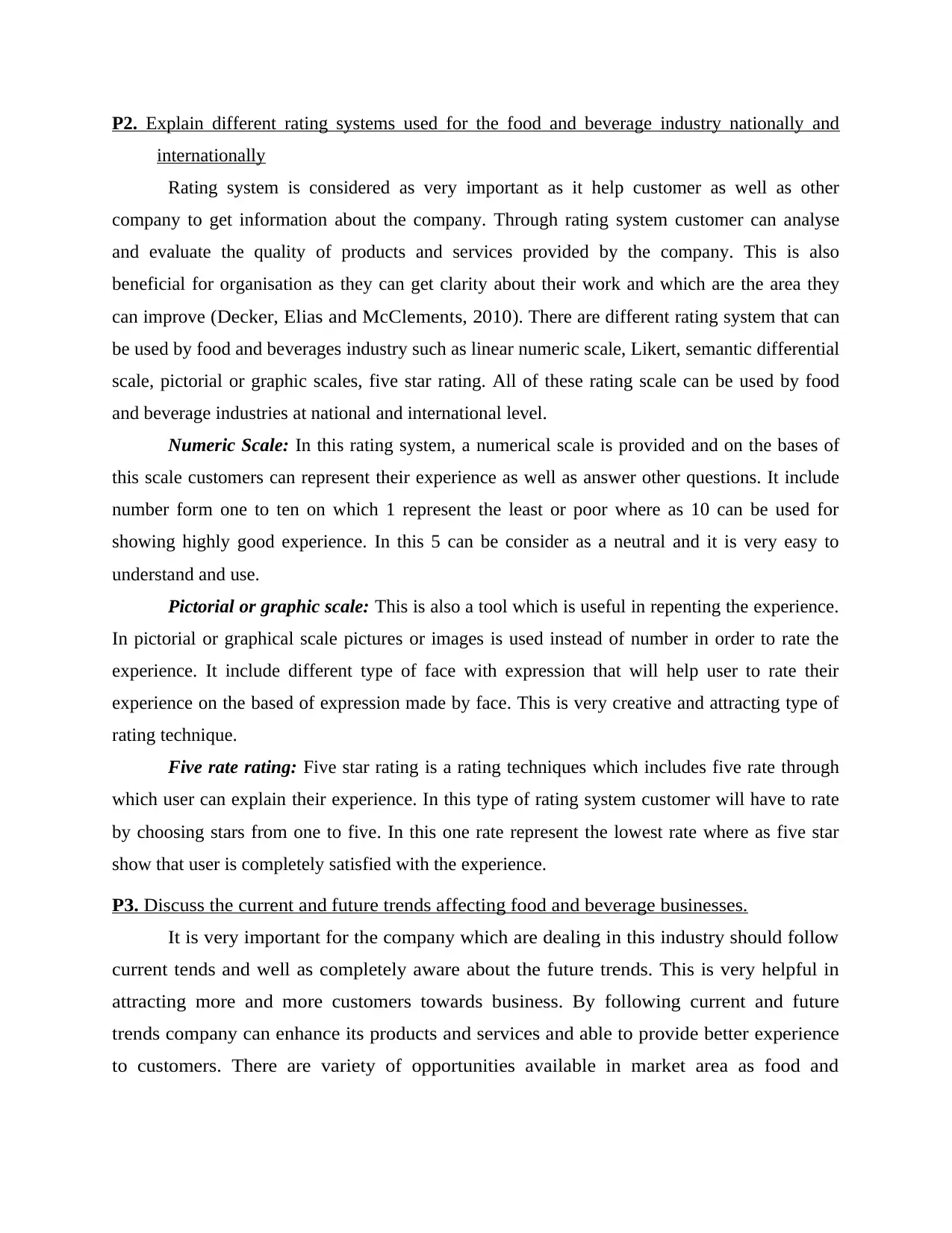
P2. Explain different rating systems used for the food and beverage industry nationally and
internationally
Rating system is considered as very important as it help customer as well as other
company to get information about the company. Through rating system customer can analyse
and evaluate the quality of products and services provided by the company. This is also
beneficial for organisation as they can get clarity about their work and which are the area they
can improve ( Decker, Elias and McClements, 2010). There are different rating system that can
be used by food and beverages industry such as linear numeric scale, Likert, semantic differential
scale, pictorial or graphic scales, five star rating. All of these rating scale can be used by food
and beverage industries at national and international level.
Numeric Scale: In this rating system, a numerical scale is provided and on the bases of
this scale customers can represent their experience as well as answer other questions. It include
number form one to ten on which 1 represent the least or poor where as 10 can be used for
showing highly good experience. In this 5 can be consider as a neutral and it is very easy to
understand and use.
Pictorial or graphic scale: This is also a tool which is useful in repenting the experience.
In pictorial or graphical scale pictures or images is used instead of number in order to rate the
experience. It include different type of face with expression that will help user to rate their
experience on the based of expression made by face. This is very creative and attracting type of
rating technique.
Five rate rating: Five star rating is a rating techniques which includes five rate through
which user can explain their experience. In this type of rating system customer will have to rate
by choosing stars from one to five. In this one rate represent the lowest rate where as five star
show that user is completely satisfied with the experience.
P3. Discuss the current and future trends affecting food and beverage businesses.
It is very important for the company which are dealing in this industry should follow
current tends and well as completely aware about the future trends. This is very helpful in
attracting more and more customers towards business. By following current and future
trends company can enhance its products and services and able to provide better experience
to customers. There are variety of opportunities available in market area as food and
internationally
Rating system is considered as very important as it help customer as well as other
company to get information about the company. Through rating system customer can analyse
and evaluate the quality of products and services provided by the company. This is also
beneficial for organisation as they can get clarity about their work and which are the area they
can improve ( Decker, Elias and McClements, 2010). There are different rating system that can
be used by food and beverages industry such as linear numeric scale, Likert, semantic differential
scale, pictorial or graphic scales, five star rating. All of these rating scale can be used by food
and beverage industries at national and international level.
Numeric Scale: In this rating system, a numerical scale is provided and on the bases of
this scale customers can represent their experience as well as answer other questions. It include
number form one to ten on which 1 represent the least or poor where as 10 can be used for
showing highly good experience. In this 5 can be consider as a neutral and it is very easy to
understand and use.
Pictorial or graphic scale: This is also a tool which is useful in repenting the experience.
In pictorial or graphical scale pictures or images is used instead of number in order to rate the
experience. It include different type of face with expression that will help user to rate their
experience on the based of expression made by face. This is very creative and attracting type of
rating technique.
Five rate rating: Five star rating is a rating techniques which includes five rate through
which user can explain their experience. In this type of rating system customer will have to rate
by choosing stars from one to five. In this one rate represent the lowest rate where as five star
show that user is completely satisfied with the experience.
P3. Discuss the current and future trends affecting food and beverage businesses.
It is very important for the company which are dealing in this industry should follow
current tends and well as completely aware about the future trends. This is very helpful in
attracting more and more customers towards business. By following current and future
trends company can enhance its products and services and able to provide better experience
to customers. There are variety of opportunities available in market area as food and
⊘ This is a preview!⊘
Do you want full access?
Subscribe today to unlock all pages.

Trusted by 1+ million students worldwide
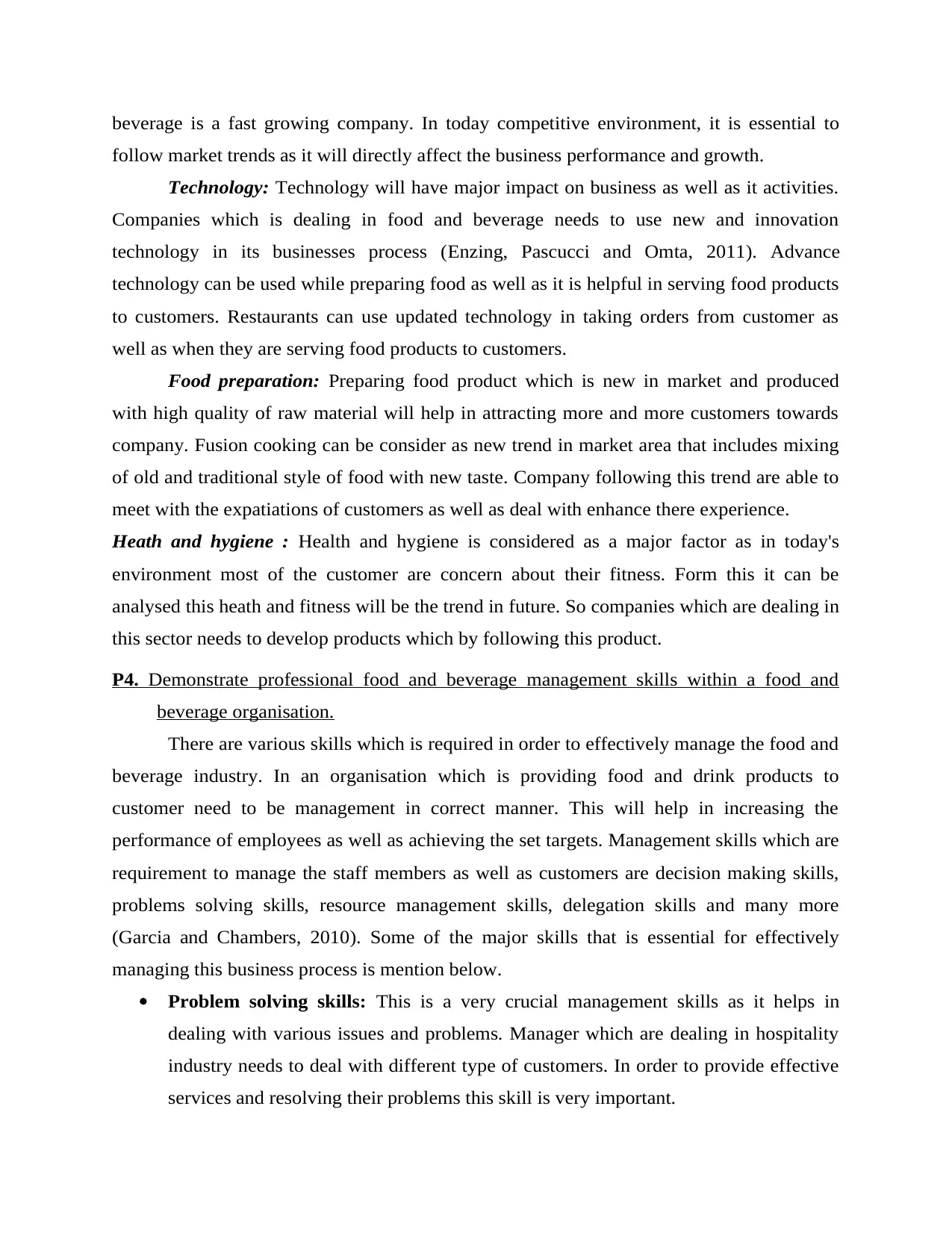
beverage is a fast growing company. In today competitive environment, it is essential to
follow market trends as it will directly affect the business performance and growth.
Technology: Technology will have major impact on business as well as it activities.
Companies which is dealing in food and beverage needs to use new and innovation
technology in its businesses process (Enzing, Pascucci and Omta, 2011). Advance
technology can be used while preparing food as well as it is helpful in serving food products
to customers. Restaurants can use updated technology in taking orders from customer as
well as when they are serving food products to customers.
Food preparation: Preparing food product which is new in market and produced
with high quality of raw material will help in attracting more and more customers towards
company. Fusion cooking can be consider as new trend in market area that includes mixing
of old and traditional style of food with new taste. Company following this trend are able to
meet with the expatiations of customers as well as deal with enhance there experience.
Heath and hygiene : Health and hygiene is considered as a major factor as in today's
environment most of the customer are concern about their fitness. Form this it can be
analysed this heath and fitness will be the trend in future. So companies which are dealing in
this sector needs to develop products which by following this product.
P4. Demonstrate professional food and beverage management skills within a food and
beverage organisation.
There are various skills which is required in order to effectively manage the food and
beverage industry. In an organisation which is providing food and drink products to
customer need to be management in correct manner. This will help in increasing the
performance of employees as well as achieving the set targets. Management skills which are
requirement to manage the staff members as well as customers are decision making skills,
problems solving skills, resource management skills, delegation skills and many more
(Garcia and Chambers, 2010). Some of the major skills that is essential for effectively
managing this business process is mention below.
Problem solving skills: This is a very crucial management skills as it helps in
dealing with various issues and problems. Manager which are dealing in hospitality
industry needs to deal with different type of customers. In order to provide effective
services and resolving their problems this skill is very important.
follow market trends as it will directly affect the business performance and growth.
Technology: Technology will have major impact on business as well as it activities.
Companies which is dealing in food and beverage needs to use new and innovation
technology in its businesses process (Enzing, Pascucci and Omta, 2011). Advance
technology can be used while preparing food as well as it is helpful in serving food products
to customers. Restaurants can use updated technology in taking orders from customer as
well as when they are serving food products to customers.
Food preparation: Preparing food product which is new in market and produced
with high quality of raw material will help in attracting more and more customers towards
company. Fusion cooking can be consider as new trend in market area that includes mixing
of old and traditional style of food with new taste. Company following this trend are able to
meet with the expatiations of customers as well as deal with enhance there experience.
Heath and hygiene : Health and hygiene is considered as a major factor as in today's
environment most of the customer are concern about their fitness. Form this it can be
analysed this heath and fitness will be the trend in future. So companies which are dealing in
this sector needs to develop products which by following this product.
P4. Demonstrate professional food and beverage management skills within a food and
beverage organisation.
There are various skills which is required in order to effectively manage the food and
beverage industry. In an organisation which is providing food and drink products to
customer need to be management in correct manner. This will help in increasing the
performance of employees as well as achieving the set targets. Management skills which are
requirement to manage the staff members as well as customers are decision making skills,
problems solving skills, resource management skills, delegation skills and many more
(Garcia and Chambers, 2010). Some of the major skills that is essential for effectively
managing this business process is mention below.
Problem solving skills: This is a very crucial management skills as it helps in
dealing with various issues and problems. Manager which are dealing in hospitality
industry needs to deal with different type of customers. In order to provide effective
services and resolving their problems this skill is very important.
Paraphrase This Document
Need a fresh take? Get an instant paraphrase of this document with our AI Paraphraser
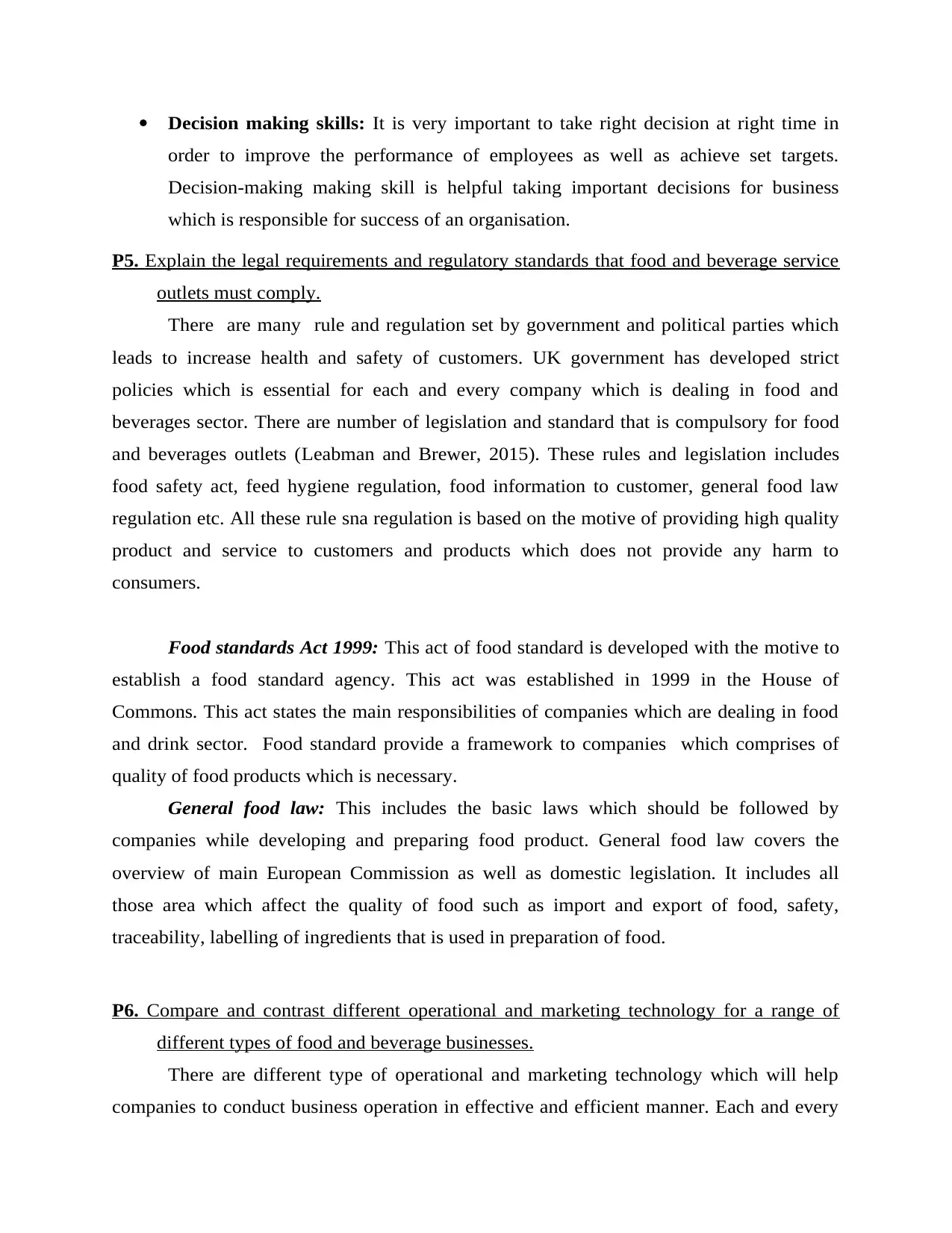
Decision making skills: It is very important to take right decision at right time in
order to improve the performance of employees as well as achieve set targets.
Decision-making making skill is helpful taking important decisions for business
which is responsible for success of an organisation.
P5. Explain the legal requirements and regulatory standards that food and beverage service
outlets must comply.
There are many rule and regulation set by government and political parties which
leads to increase health and safety of customers. UK government has developed strict
policies which is essential for each and every company which is dealing in food and
beverages sector. There are number of legislation and standard that is compulsory for food
and beverages outlets (Leabman and Brewer, 2015). These rules and legislation includes
food safety act, feed hygiene regulation, food information to customer, general food law
regulation etc. All these rule sna regulation is based on the motive of providing high quality
product and service to customers and products which does not provide any harm to
consumers.
Food standards Act 1999: This act of food standard is developed with the motive to
establish a food standard agency. This act was established in 1999 in the House of
Commons. This act states the main responsibilities of companies which are dealing in food
and drink sector. Food standard provide a framework to companies which comprises of
quality of food products which is necessary.
General food law: This includes the basic laws which should be followed by
companies while developing and preparing food product. General food law covers the
overview of main European Commission as well as domestic legislation. It includes all
those area which affect the quality of food such as import and export of food, safety,
traceability, labelling of ingredients that is used in preparation of food.
P6. Compare and contrast different operational and marketing technology for a range of
different types of food and beverage businesses.
There are different type of operational and marketing technology which will help
companies to conduct business operation in effective and efficient manner. Each and every
order to improve the performance of employees as well as achieve set targets.
Decision-making making skill is helpful taking important decisions for business
which is responsible for success of an organisation.
P5. Explain the legal requirements and regulatory standards that food and beverage service
outlets must comply.
There are many rule and regulation set by government and political parties which
leads to increase health and safety of customers. UK government has developed strict
policies which is essential for each and every company which is dealing in food and
beverages sector. There are number of legislation and standard that is compulsory for food
and beverages outlets (Leabman and Brewer, 2015). These rules and legislation includes
food safety act, feed hygiene regulation, food information to customer, general food law
regulation etc. All these rule sna regulation is based on the motive of providing high quality
product and service to customers and products which does not provide any harm to
consumers.
Food standards Act 1999: This act of food standard is developed with the motive to
establish a food standard agency. This act was established in 1999 in the House of
Commons. This act states the main responsibilities of companies which are dealing in food
and drink sector. Food standard provide a framework to companies which comprises of
quality of food products which is necessary.
General food law: This includes the basic laws which should be followed by
companies while developing and preparing food product. General food law covers the
overview of main European Commission as well as domestic legislation. It includes all
those area which affect the quality of food such as import and export of food, safety,
traceability, labelling of ingredients that is used in preparation of food.
P6. Compare and contrast different operational and marketing technology for a range of
different types of food and beverage businesses.
There are different type of operational and marketing technology which will help
companies to conduct business operation in effective and efficient manner. Each and every
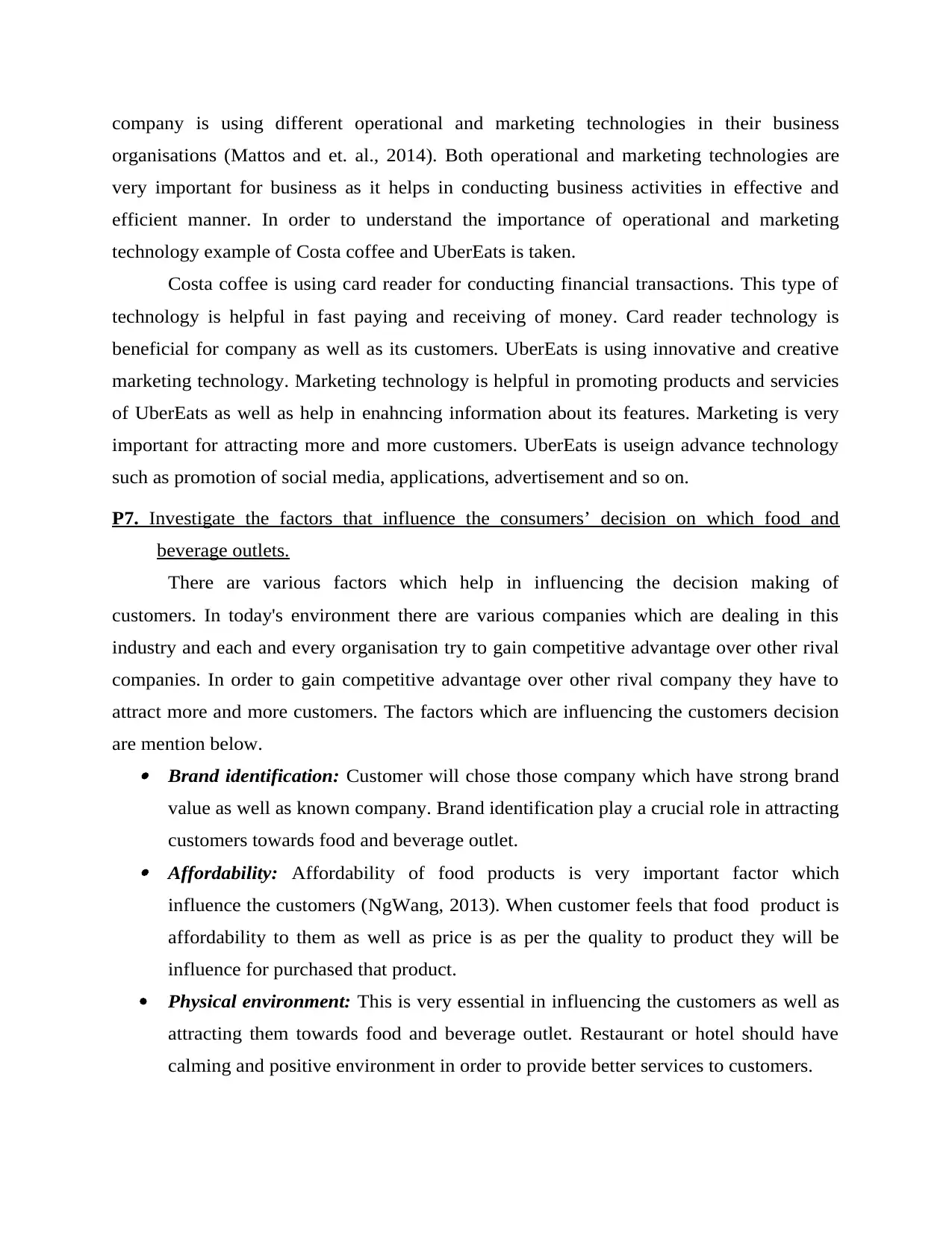
company is using different operational and marketing technologies in their business
organisations (Mattos and et. al., 2014). Both operational and marketing technologies are
very important for business as it helps in conducting business activities in effective and
efficient manner. In order to understand the importance of operational and marketing
technology example of Costa coffee and UberEats is taken.
Costa coffee is using card reader for conducting financial transactions. This type of
technology is helpful in fast paying and receiving of money. Card reader technology is
beneficial for company as well as its customers. UberEats is using innovative and creative
marketing technology. Marketing technology is helpful in promoting products and servicies
of UberEats as well as help in enahncing information about its features. Marketing is very
important for attracting more and more customers. UberEats is useign advance technology
such as promotion of social media, applications, advertisement and so on.
P7. Investigate the factors that influence the consumers’ decision on which food and
beverage outlets.
There are various factors which help in influencing the decision making of
customers. In today's environment there are various companies which are dealing in this
industry and each and every organisation try to gain competitive advantage over other rival
companies. In order to gain competitive advantage over other rival company they have to
attract more and more customers. The factors which are influencing the customers decision
are mention below.
Brand identification: Customer will chose those company which have strong brand
value as well as known company. Brand identification play a crucial role in attracting
customers towards food and beverage outlet.
Affordability: Affordability of food products is very important factor which
influence the customers (NgWang, 2013). When customer feels that food product is
affordability to them as well as price is as per the quality to product they will be
influence for purchased that product.
Physical environment: This is very essential in influencing the customers as well as
attracting them towards food and beverage outlet. Restaurant or hotel should have
calming and positive environment in order to provide better services to customers.
organisations (Mattos and et. al., 2014). Both operational and marketing technologies are
very important for business as it helps in conducting business activities in effective and
efficient manner. In order to understand the importance of operational and marketing
technology example of Costa coffee and UberEats is taken.
Costa coffee is using card reader for conducting financial transactions. This type of
technology is helpful in fast paying and receiving of money. Card reader technology is
beneficial for company as well as its customers. UberEats is using innovative and creative
marketing technology. Marketing technology is helpful in promoting products and servicies
of UberEats as well as help in enahncing information about its features. Marketing is very
important for attracting more and more customers. UberEats is useign advance technology
such as promotion of social media, applications, advertisement and so on.
P7. Investigate the factors that influence the consumers’ decision on which food and
beverage outlets.
There are various factors which help in influencing the decision making of
customers. In today's environment there are various companies which are dealing in this
industry and each and every organisation try to gain competitive advantage over other rival
companies. In order to gain competitive advantage over other rival company they have to
attract more and more customers. The factors which are influencing the customers decision
are mention below.
Brand identification: Customer will chose those company which have strong brand
value as well as known company. Brand identification play a crucial role in attracting
customers towards food and beverage outlet.
Affordability: Affordability of food products is very important factor which
influence the customers (NgWang, 2013). When customer feels that food product is
affordability to them as well as price is as per the quality to product they will be
influence for purchased that product.
Physical environment: This is very essential in influencing the customers as well as
attracting them towards food and beverage outlet. Restaurant or hotel should have
calming and positive environment in order to provide better services to customers.
⊘ This is a preview!⊘
Do you want full access?
Subscribe today to unlock all pages.

Trusted by 1+ million students worldwide
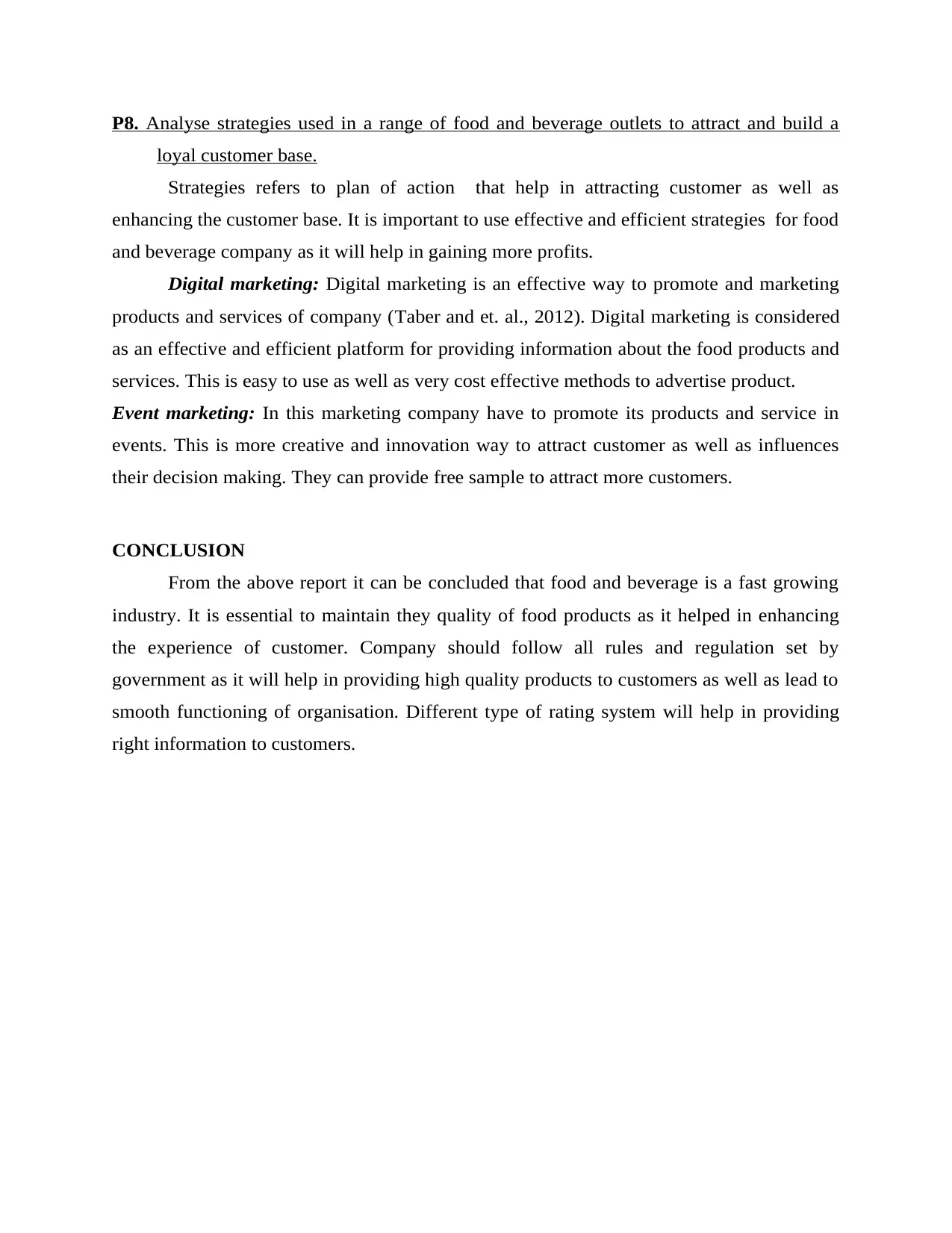
P8. Analyse strategies used in a range of food and beverage outlets to attract and build a
loyal customer base.
Strategies refers to plan of action that help in attracting customer as well as
enhancing the customer base. It is important to use effective and efficient strategies for food
and beverage company as it will help in gaining more profits.
Digital marketing: Digital marketing is an effective way to promote and marketing
products and services of company (Taber and et. al., 2012). Digital marketing is considered
as an effective and efficient platform for providing information about the food products and
services. This is easy to use as well as very cost effective methods to advertise product.
Event marketing: In this marketing company have to promote its products and service in
events. This is more creative and innovation way to attract customer as well as influences
their decision making. They can provide free sample to attract more customers.
CONCLUSION
From the above report it can be concluded that food and beverage is a fast growing
industry. It is essential to maintain they quality of food products as it helped in enhancing
the experience of customer. Company should follow all rules and regulation set by
government as it will help in providing high quality products to customers as well as lead to
smooth functioning of organisation. Different type of rating system will help in providing
right information to customers.
loyal customer base.
Strategies refers to plan of action that help in attracting customer as well as
enhancing the customer base. It is important to use effective and efficient strategies for food
and beverage company as it will help in gaining more profits.
Digital marketing: Digital marketing is an effective way to promote and marketing
products and services of company (Taber and et. al., 2012). Digital marketing is considered
as an effective and efficient platform for providing information about the food products and
services. This is easy to use as well as very cost effective methods to advertise product.
Event marketing: In this marketing company have to promote its products and service in
events. This is more creative and innovation way to attract customer as well as influences
their decision making. They can provide free sample to attract more customers.
CONCLUSION
From the above report it can be concluded that food and beverage is a fast growing
industry. It is essential to maintain they quality of food products as it helped in enhancing
the experience of customer. Company should follow all rules and regulation set by
government as it will help in providing high quality products to customers as well as lead to
smooth functioning of organisation. Different type of rating system will help in providing
right information to customers.
Paraphrase This Document
Need a fresh take? Get an instant paraphrase of this document with our AI Paraphraser
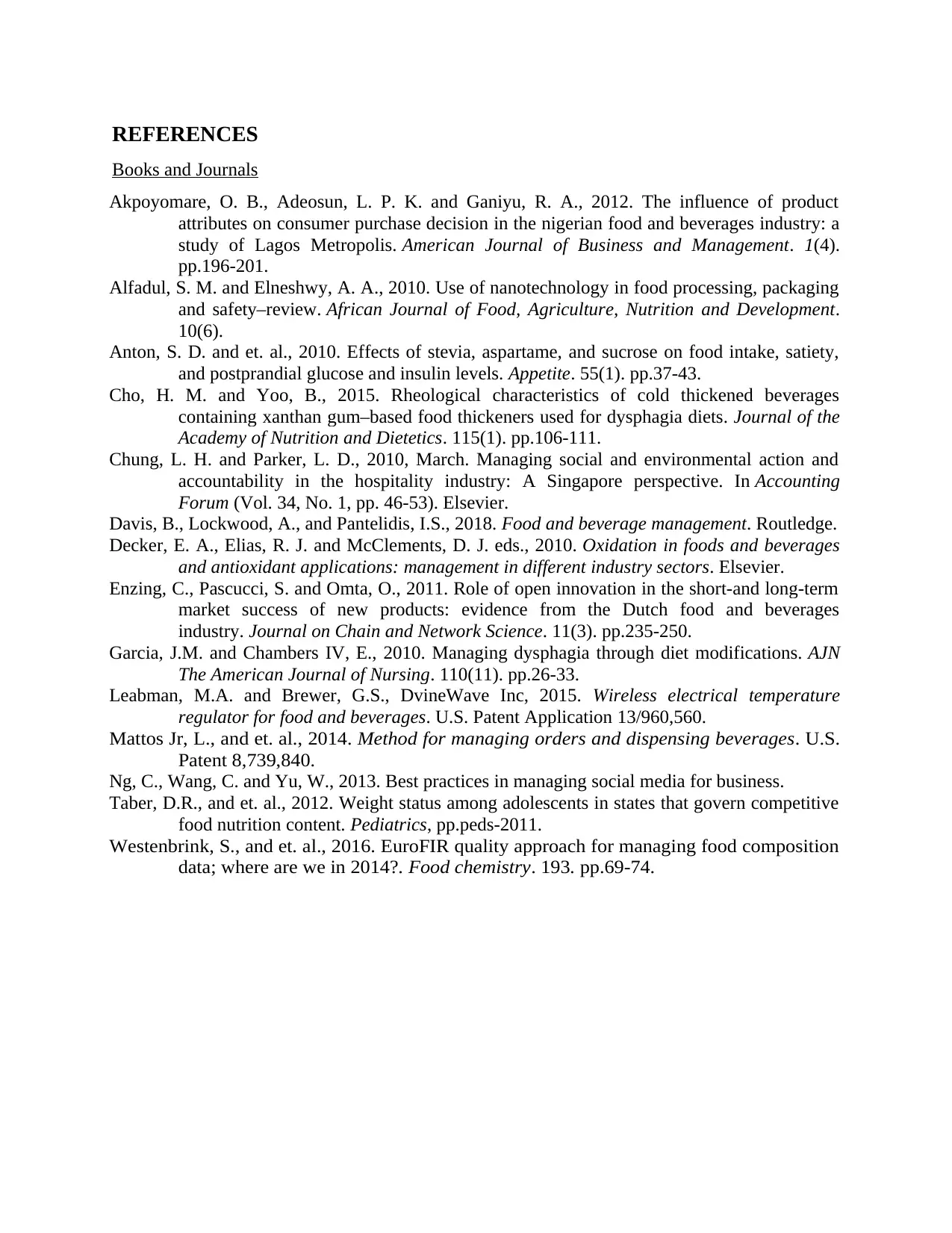
REFERENCES
Books and Journals
Akpoyomare, O. B., Adeosun, L. P. K. and Ganiyu, R. A., 2012. The influence of product
attributes on consumer purchase decision in the nigerian food and beverages industry: a
study of Lagos Metropolis. American Journal of Business and Management. 1(4).
pp.196-201.
Alfadul, S. M. and Elneshwy, A. A., 2010. Use of nanotechnology in food processing, packaging
and safety–review. African Journal of Food, Agriculture, Nutrition and Development.
10(6).
Anton, S. D. and et. al., 2010. Effects of stevia, aspartame, and sucrose on food intake, satiety,
and postprandial glucose and insulin levels. Appetite. 55(1). pp.37-43.
Cho, H. M. and Yoo, B., 2015. Rheological characteristics of cold thickened beverages
containing xanthan gum–based food thickeners used for dysphagia diets. Journal of the
Academy of Nutrition and Dietetics. 115(1). pp.106-111.
Chung, L. H. and Parker, L. D., 2010, March. Managing social and environmental action and
accountability in the hospitality industry: A Singapore perspective. In Accounting
Forum (Vol. 34, No. 1, pp. 46-53). Elsevier.
Davis, B., Lockwood, A., and Pantelidis, I.S., 2018. Food and beverage management. Routledge.
Decker, E. A., Elias, R. J. and McClements, D. J. eds., 2010. Oxidation in foods and beverages
and antioxidant applications: management in different industry sectors. Elsevier.
Enzing, C., Pascucci, S. and Omta, O., 2011. Role of open innovation in the short-and long-term
market success of new products: evidence from the Dutch food and beverages
industry. Journal on Chain and Network Science. 11(3). pp.235-250.
Garcia, J.M. and Chambers IV, E., 2010. Managing dysphagia through diet modifications. AJN
The American Journal of Nursing. 110(11). pp.26-33.
Leabman, M.A. and Brewer, G.S., DvineWave Inc, 2015. Wireless electrical temperature
regulator for food and beverages. U.S. Patent Application 13/960,560.
Mattos Jr, L., and et. al., 2014. Method for managing orders and dispensing beverages. U.S.
Patent 8,739,840.
Ng, C., Wang, C. and Yu, W., 2013. Best practices in managing social media for business.
Taber, D.R., and et. al., 2012. Weight status among adolescents in states that govern competitive
food nutrition content. Pediatrics, pp.peds-2011.
Westenbrink, S., and et. al., 2016. EuroFIR quality approach for managing food composition
data; where are we in 2014?. Food chemistry. 193. pp.69-74.
Books and Journals
Akpoyomare, O. B., Adeosun, L. P. K. and Ganiyu, R. A., 2012. The influence of product
attributes on consumer purchase decision in the nigerian food and beverages industry: a
study of Lagos Metropolis. American Journal of Business and Management. 1(4).
pp.196-201.
Alfadul, S. M. and Elneshwy, A. A., 2010. Use of nanotechnology in food processing, packaging
and safety–review. African Journal of Food, Agriculture, Nutrition and Development.
10(6).
Anton, S. D. and et. al., 2010. Effects of stevia, aspartame, and sucrose on food intake, satiety,
and postprandial glucose and insulin levels. Appetite. 55(1). pp.37-43.
Cho, H. M. and Yoo, B., 2015. Rheological characteristics of cold thickened beverages
containing xanthan gum–based food thickeners used for dysphagia diets. Journal of the
Academy of Nutrition and Dietetics. 115(1). pp.106-111.
Chung, L. H. and Parker, L. D., 2010, March. Managing social and environmental action and
accountability in the hospitality industry: A Singapore perspective. In Accounting
Forum (Vol. 34, No. 1, pp. 46-53). Elsevier.
Davis, B., Lockwood, A., and Pantelidis, I.S., 2018. Food and beverage management. Routledge.
Decker, E. A., Elias, R. J. and McClements, D. J. eds., 2010. Oxidation in foods and beverages
and antioxidant applications: management in different industry sectors. Elsevier.
Enzing, C., Pascucci, S. and Omta, O., 2011. Role of open innovation in the short-and long-term
market success of new products: evidence from the Dutch food and beverages
industry. Journal on Chain and Network Science. 11(3). pp.235-250.
Garcia, J.M. and Chambers IV, E., 2010. Managing dysphagia through diet modifications. AJN
The American Journal of Nursing. 110(11). pp.26-33.
Leabman, M.A. and Brewer, G.S., DvineWave Inc, 2015. Wireless electrical temperature
regulator for food and beverages. U.S. Patent Application 13/960,560.
Mattos Jr, L., and et. al., 2014. Method for managing orders and dispensing beverages. U.S.
Patent 8,739,840.
Ng, C., Wang, C. and Yu, W., 2013. Best practices in managing social media for business.
Taber, D.R., and et. al., 2012. Weight status among adolescents in states that govern competitive
food nutrition content. Pediatrics, pp.peds-2011.
Westenbrink, S., and et. al., 2016. EuroFIR quality approach for managing food composition
data; where are we in 2014?. Food chemistry. 193. pp.69-74.

1
⊘ This is a preview!⊘
Do you want full access?
Subscribe today to unlock all pages.

Trusted by 1+ million students worldwide
1 out of 12
Related Documents
Your All-in-One AI-Powered Toolkit for Academic Success.
+13062052269
info@desklib.com
Available 24*7 on WhatsApp / Email
![[object Object]](/_next/static/media/star-bottom.7253800d.svg)
Unlock your academic potential
Copyright © 2020–2025 A2Z Services. All Rights Reserved. Developed and managed by ZUCOL.




